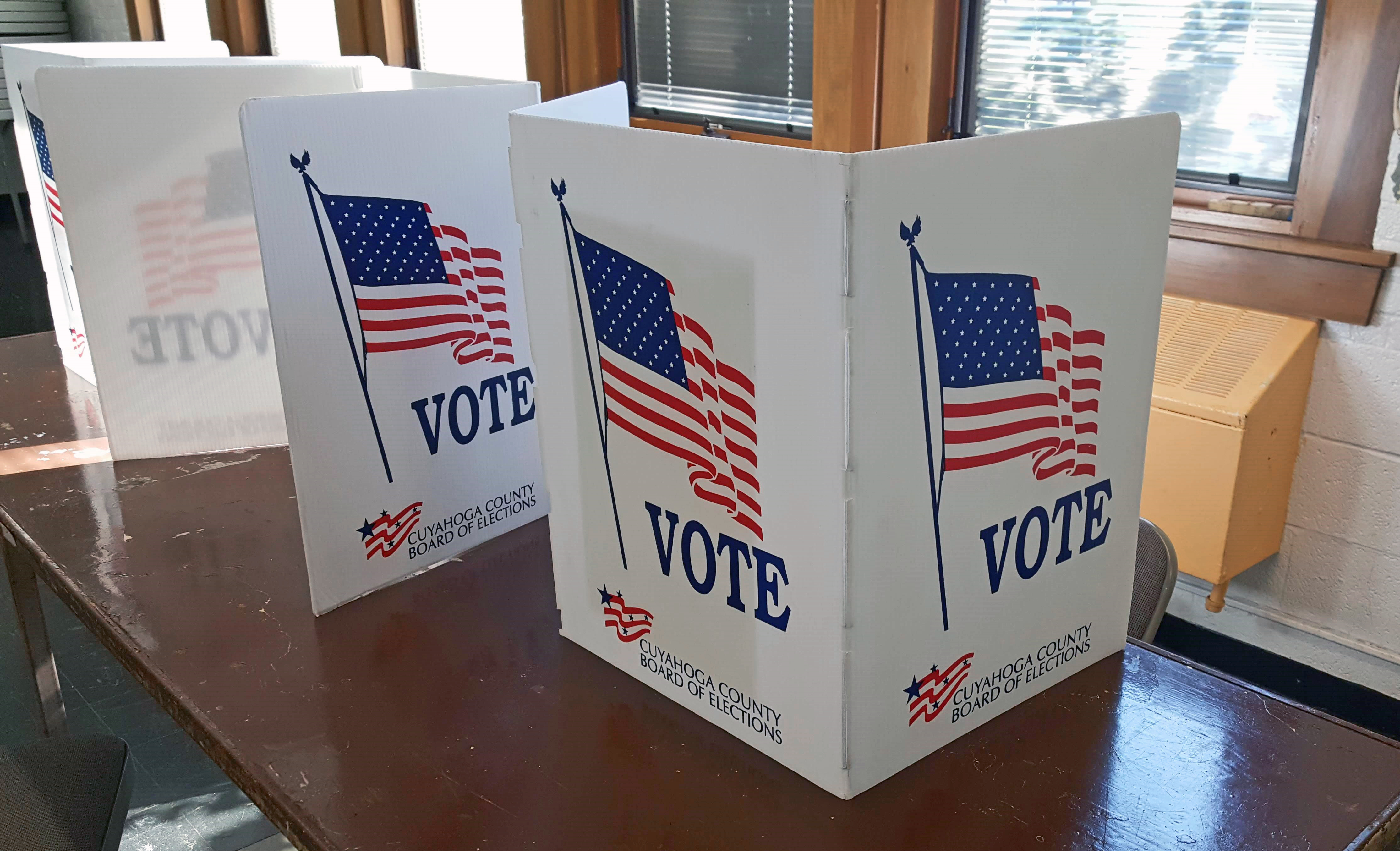Iowa’s 2020 Primary in the Wake of the Coronavirus
Iowa had record voter turnout in its June primary. Can it replicate this success in the general election?

Published by The Lawfare Institute
in Cooperation With

Lawfare is partnering with the Stanford-MIT Healthy Elections Project to produce a series on election integrity in the midst of the coronavirus crisis. The Healthy Elections Project aims to assist election officials and the public as the nation confronts the challenges that the coronavirus pandemic poses for election administration. Through student-driven research, tool development, and direct services to jurisdictions, the project focuses on confronting the logistical challenges faced by states as they make rapid transitions to mail balloting and the creation of safe polling places. Read other installments in the series here.
Iowa saw record voter participation for its June 2 primary, despite having fewer than half the number of physical polling places as in the June 2018 primary. This increase in voter participation was attributable in large part to the 10-fold increase in absentee voting compared to 2018, driven in part by Secretary of State Paul Pate’s decision to mail absentee ballot request forms to all of the approximately 2 million active registered voters in Iowa.
Nevertheless, there are potential challenges to replicating these successes in the November election. New legislation reined in the secretary of state’s ability to alter election procedures, and future changes to centralized election procedures now require approval from the state’s legislative council. Iowa may thus see greater variances across county voting procedures for November and may experience related communication challenges, especially in rural counties. Polling place consolidation may also spark concerns of potential political discrimination.
Our full report on Iowa can be found here.
Background
Iowa held its presidential caucus on Feb. 3, before coronavirus had significantly affected election procedures. However, Iowa held an additional primary election on June 2 for federal and state offices, including the U.S. Senate, U.S. House of Representatives, Iowa State Senate, and Iowa State House of Representatives.
Beginning in March, Republican Governor Kim Reynolds signed a series of Proclamations of Disaster Emergency implementing response measures to the coronavirus, including ordering closures of businesses, venues and nonessential services, and suspending regulations to promote necessary supply distribution. Proclamations issued in late spring and early summer permitted gradual reopening, including mass gatherings, under special public health guidelines. The statewide emergency declaration as well as guidelines and limitations on reopening have been extended until Sept. 20. As of Aug. 28, more than 62,000 Iowans have tested positive for the coronavirus and 1,091 have died.
Reynolds’s May 26 proclamation just before the June primary included a specific section on election activities, clarifying that prohibitions on mass gatherings do not apply to voting or training for precinct election officials. The proclamation also affirmed that the closure of schools and certain public venues does not prohibit the operation of polling places at those locations.
Voting by Mail in the Primary
Under Iowa state law already in place before the coronavirus pandemic, registered Iowans may request a no-excuse absentee ballot by filling out the request form and returning the signed original copy to their county auditor at least 11 days before a primary or 10 days before a general election. Voters who become a patient at a hospital or health care facility within three days of an election may request an emergency absentee ballot.
Voters may return the absentee ballot by mail or in person at their county auditor’s office and can designate another person to deliver the completed ballot. If delivered by mail, the ballot must be postmarked at least one day before Election Day and received no more than six days after Election Day. Once submitted, voters may track the status of their absentee ballot online. There is no witness requirement to verify mail-in ballots. Election officials will verify the signed voter affidavit and confirm that the signature matches the signature on file. Signature defects can be cured until 5:00 p.m. on the day before the election.
Voters may not return their absentee ballots at polling locations on Election Day. However, they can surrender their absentee ballots at the polls and instead vote in person on Election Day, or complete a provisional ballot at the polls if they cannot surrender their absentee ballots.
In response to the public health challenges posed by the coronavirus, Secretary Pate announced on March 31 that his office would mail an absentee ballot request form to every active registered voter in Iowa for the primary. In an official statement, Pate said that “[t]he safest way to vote will be by mail.” Ballot request forms were sent to more than 2 million registered voters and were also available online. Voters were able to request absentee ballots until May 22 for the June 2 primary. Pate also extended the statutory 29-day early voting period to 40 days. Voters could return completed ballots for the June primary as early as April 23.
The ballot request forms mailed to all registered voters included prepaid return postage and were in the form of a postcard. The lack of envelope enclosure raised concerns: Iowans pointed out that voters’ personal information, such as date of birth, address, ID number and political affiliation, was readily apparent on the face of the completed form.
In response to these concerns, the office of the Iowa secretary of state explained in a statement to county auditors that the postcard-style form had been recommended by the U.S. Postal Service and by a vendor, and that a similar format had been used many times by various campaigns and advocacy groups. The office also provided instructions to voters on how they could fold and tape the ballot request form in such a way to hide the personal information, but cautioned that if masking tape or staples were used, the ballot request form could be rejected. It is unclear to what extent, if any, concerns about disclosure of personal information affected the number of absentee ballot requests and submissions.
Iowa saw a significant increase in voter turnout in the primary, largely driven by increased absentee voting. More than half a million Iowans voted in the primary, with just over 420,000 voting absentee. These figures represent an astounding 10-fold increase in the use of absentee ballots compared to the June 2016 primary, in which only 38,000 completed ballots were returned. Turnout was also significantly higher than Iowa’s 2018 primary, in which fewer than 300,000 total votes and just slightly over 50,000 absentee votes were cast. Republican turnout in the 2020 primary was around 35 percent and Democratic turnout was around 39 percent, compared to roughly 15 percent for both parties in 2016.
In-Person Voting in the Primary
Iowa permits same-day registration for in-person voting on Election Day. Voters may also register in advance online or by mail. Polls are open from 7:00 a.m. until 9:00 p.m. statewide.
Voters in Iowa must present identification for in-person voting. A voter who cannot present an acceptable ID may vote if another person who is registered to vote in that precinct submits a written and signed affidavit attesting to the stated identity and current residency of the voter without ID. However, no person can attest to the identities of more than two voters without IDs on a single day. A voter who cannot provide a qualifying ID or an attestation by another registered voter may submit a provisional ballot.
Pate announced in March that in-person voting would be an option for the June 2 primary election. Additionally, curbside voting would be an option for Iowans with disabilities, those with trouble entering a polling place, and those in the Centers for Disease Control and Prevention’s at-risk groups for severe symptoms and death resulting from COVID-19, the respiratory disease caused by the coronavirus. In curbside voting, two officials, one from each political party, bring ballot materials to the voter’s car, who is able to mark their ballot without leaving the vehicle. No advance notice is required to vote curbside.
However, Pate announced that many precincts would be consolidated, combining two or more unique precincts into one location, to lessen the need for poll workers and interior space during the pandemic. Counties in Iowa had varying rates of polling site consolidation. Some counties saw no decrease in the number of polling sites compared to 2018 while others saw a significant decrease. For example, the most populous county in Iowa, Polk County, saw a decrease from 135 polling places to just 28. In the 2020 primary, Iowa had fewer than one-third of the polling places that it had in 2018.
Polling place closures sparked some concerns of discrimination. When Woodbury County election officials first announced there would be only two polling locations countywide for the June primary, a former Iowa state senator filed suit against the county officials alleging that the decreased number of polling locations would disadvantage voters in the Republican Party. The parties resolved the lawsuit after Woodbury County agreed to open three additional polling locations.
The Iowa National Guard delivered personal protective equipment (PPE) to polling precincts in an effort to equitably protect poll workers statewide, and counties implemented social distancing measures. Iowa paid for the PPE through the $4 million in federal funds provided by the CARES Act to help with elections during the pandemic. Moreover, the state provided $500,000 in grants to help counties prepare for the primaries. These funds were also funneled toward recruiting and paying younger poll workers who faced lower risk from the coronavirus than Iowa’s typical roster of older poll workers. County officials had masks available for voters, and some even bought extra pens so that voters could avoid sharing touched surfaces. Poll workers were required to wear masks and mandated to wipe down surfaces.
Iowa’s in-person polling was not as busy as previous years, despite the decline in numbers of polling locations. Most Iowa primary voters had already cast their ballots through the mail before Election Day. Of the 531,131 votes cast in the June 2 primary, nearly 80 percent were by absentee ballot; only around 110,000 constituents voted in person across Iowa’s 99 counties, including in-person early voting. Reports of in-person voting experiences in the primary were mostly positive and included few lines and crowds, heightened sanitation procedures, and timely allocation of PPE.
Certain county officials made an extra effort to ensure voting accessibility and safety. In Johnson County, election officials set up a drive-through voting booth outside the county administration building, and staff wearing PPE accepted voters’ ballots directly from their vehicles. In Grundy County, officials established a curbside ballot drop-off system at the county office. Meanwhile, in Ringgold County, voters could cast their ballots in an isolated conference room at the closed courthouse.
But challenges remained for in-person voting during the June primary. Certain county auditors expressed difficulty in finding and training new and willing poll workers. And while volunteers trained in coronavirus safety measures did not report receiving negative comments from voters when they were offered hand sanitizer and masks, Iowa also does not have a mandatory mask order, and election workers could not force voters to wear masks.
Several rural counties opted to keep only one active polling location. Some voters said that they were not sufficiently informed about the updated polling locations and drove to their usual polling locations, only to be diverted. Voter confusion in these areas may be partly attributable to the limited media outlets or publications in certain rural locations.
Challenges in Expanding and Promoting Vote-by-Mail for the General Election
Despite a successful primary driven largely by absentee voting procedures directed by Pate, members of the state legislature indicated concern that the secretary of state had unilateral emergency powers to alter election procedures without an accountability mechanism. Days after the June 2 primary, the Iowa Senate passed a bill prohibiting the secretary of state from mailing absentee ballots without written requests from voters. The bill was amended in the Iowa House of Representatives on June 11 and signed into law on June 24. As amended, the bill does not prohibit the secretary of state from altering election procedures but requires prior approval from the legislative council, made up of Democratic and Republican leadership, and limits the extent to which the secretary of state can consolidate polling locations.
Under the new procedures, an Iowa state senator proposed that the legislative council grant Pate approval to send absentee ballot request forms to all registered voters for the Nov. 3 general election—essentially repeating the process from the primary. The legislative council denied this proposal.
In the absence of a directive from the secretary of state, the discretion to send ballot request forms to all registered voters rested with the counties. On July 7, for example, the Polk County auditor indicated that his office would send every registered voter an absentee ballot request form before the November election. But smaller counties expressed concern over the financial strain of self-funding ballot request forms in the general election. In Benton County, officials estimated that a mass mailing would have siphoned up to 15 percent from the county’s total general election budget. Larger counties, like Black Hawk, Dubuque, Johnson and Linn, planned to mail ballot request forms automatically despite high costs: For example, Johnson County’s election budget included $100,000 dedicated to mailing absentee ballot request forms to all active registered voters. The fragmented county response led to involvement from third-party organizations to disseminate absentee ballot request forms to alleviate resource concerns in the absence of a statewide mandate.
On July 17, Pate announced an emergency directive to conduct a statewide mailing of absentee ballot request forms to Iowa’s active registered voters for the November general election. In his announcement, Pate stated that he had consulted with all 99 county auditors and determined that the mailers were the best way to conduct a safe election. Under the emergency directive, voters retain the option to cast their ballots in person, and Pate provided assurance that the state would “provide resources to protect Iowans” who choose in-person voting. The 24-member legislative council reviewed and approved Pate’s directive on July 17. The announcement came after several counties had self-funded and sent out absentee ballot request forms to their active voters.
The Republican National Committee issued a letter on July 27 to Pate asking that the secretary prohibit counties from mailing absentee ballot request forms with prepopulated information. Pate did not formally respond to this request, but at least two counties—Linn and Johnson—mailed absentee ballot request forms with prepopulated information to voters. By the end of July, Linn County had mailed 100,000 absentee ballot request forms with prepopulated information, 13,000 of which were signed and returned by the end of that month.
Further disagreement and variance surrounding voter information emerged at the county level. On ballot request forms, voters must include either their Iowa driver’s license number or a voter PIN, a four-digit number included on Iowa voter ID cards. Since many voters do not know their PINs, Johnson and Linn County auditors both planned to include the numbers preprinted on the ballot request forms they mail. However, on July 6, the director of elections for the secretary of state office sent an email to county officials, stating that “[t]he ID Number field can NOT be prepopulated because it is considered a confidential record.” Nevertheless, Linn County sent its mailers with voter PINs included. An Iowa trial judge issued a temporary injunction on August 27, nullifying 45,000 returned ballot request forms issued with PINs and ordering the county to notify other voters that they must now reapply for absentee ballots.
Reporting from the Des Moines Register has shone a light on the state’s policy toward ballot drop boxes. In a series of auditor trainings in late August, the secretary of state’s office told county auditors that they cannot use drop boxes to collect absentee ballots in the general election under the office’s interpretation of an Iowa law governing ballot submission. Several counties used drop boxes during the primary as an option for voters and more than one-third of auditors have used drop boxes in the past, but the secretary of state’s office stated that “auditors do not have authority to establish a ballot drop box system in their county.” However, the office did say that auditors can set up “no-contact delivery” systems in their office during regular business hours.
Nevertheless, several counties still intend to use their drop boxes. The Linn County Board of Supervisors voted on Aug. 26 to classify all drop boxes as “county-provided accessories” of the auditor’s office. Linn County Auditor Joel Miller said that their goal was to classify all drop boxes as part of the auditor’s office in order to continue using them. Similarly, Montgomery County Auditor Stephanie Burke purchased a drop box this spring amid coronavirus concerns and still plans to use the box, assuring voters that any ballots received in the drop box on time would be counted for November. It is unclear to what extent differing interpretations of Iowa law governing drop boxes and varying county responses to the secretary of state’s directive will impact absentee ballot return rates in November.
Challenges for November
Iowa increased voter turnout in its June 2 primary despite shutting down many in-person voting locations, largely because of its investments in absentee balloting. The legislative council approved a similar absentee ballot request procedure for the general election as in the June primary. Nevertheless, Iowa will need to navigate difficult logistical challenges for November:
- Ongoing changes to vote-by-mail policy: With the secretary of state’s new instructions to auditors prohibiting drop boxes, there is uncertainty surrounding the scope and interpretation of Iowa law. Differing county approaches to drop boxes may lead to voter uncertainty and litigation, and could limit voters’ ballot-return options for November.
- Differing county responses: With new legislation in place limiting the secretary of state’s ability to implement centralized measures, it is likely that individual county auditors will fashion their own solutions, creating a more fragmented regulatory landscape.
- Voter confusion because of local changes: With the expectation that there may be greater variance among individual counties’ November election procedures, it is crucial to provide voters with county-specific updates of procedures. In rural counties with few local media outlets and publications, officials should consider alternative conduits for disseminating new information. For example, officials could use social media, post flyers in local businesses and designate specific individuals to inform their communities.
- Difficulty scaling and replicating successful June measures: Officials should assess the success, applicability, and feasibility of nontraditional in-person voting procedures such as drive-through or curbside voting. Employing these measures more widely may help counties maintain more polling locations safely by minimizing contact among voters and likely requiring less overhead in terms of PPE and demand for internal space.
- Impact of polling place consolidations: Further study is needed to assess the impact of polling place consolidation to ensure that no bias occurs on the basis of race or party.









